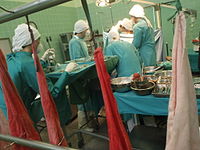
Photo from wikipedia
Ovarian tissue transplantation (OTT) is a technique well established and successfully applied in humans using mainly orthotopic or heterotopic transplantation sites. In livestock, OTT is still in its infancy and,… Click to show full abstract
Ovarian tissue transplantation (OTT) is a technique well established and successfully applied in humans using mainly orthotopic or heterotopic transplantation sites. In livestock, OTT is still in its infancy and, therefore, different aspects of the technique, including the efficiency of different heterotopic OTT sites as well as the potential effect of age (i.e., young vs. old mares) in the ovarian graft quality, need to be investigated. The present study investigated the efficacy of the intramuscular (IM) or the novel subvulvar mucosa (SV) heterotopic autotransplantation sites to maintain the survivability of the grafts for 3 and 7 days post-OTT. Ovarian biopsy fragments were obtained in vivo and distributed to the following treatments: Fresh control group (ovarian fragments immediately fixed), SV-3, IM-3, SV-7, and IM-7. During and after graft harvesting, the macroscopic characteristics of the grafts (i.e., adherence, morphology, and bleeding) were scored, and the percentages of morphologically normal and developing preantral follicles as well as the follicular and stromal cell densities of the grafts were evaluated. The results were that similar (P > 0.05) macroscopic scores were observed between both transplantation sites 7 days post-OTT, with positive correlations (P < 0.01) found among adherence, morphology, and bleeding of the grafts. A lower (P < 0.05) percentage of morphologically normal follicles was found 7 days post-OTT in the SV site (82%) compared with the Fresh control group (99%) and IM site (95%); however, the percentages of developing follicles were similar (P > 0.05) between both transplantation sites 7 days post-OTT (30-43%). Although similar (P > 0.05) follicular densities were found in both transplantation sites in young and old mares at 3 and 7 days post-OTT, large individual variation in the follicular depletion rate was observed regardless of transplantation site. The Fresh control group and SV-7 treatments had higher (P < 0.05) stromal cell densities in young and old mares compared with both IM-7 treatments. When comparing transplant sites between young and old mares, the follicular density in old mares and the stromal cell density in young mares were greater (P < 0.05) in the SV than in the IM site. In conclusion, even though the transplantation sites differentially affected some end points, overall comparable findings of the OTT technique using both heterotopic autotransplantation sites (i.e., IM and SV) for equine ovarian tissue were observed.
Journal Title: Theriogenology
Year Published: 2021
Link to full text (if available)
Share on Social Media: Sign Up to like & get
recommendations!